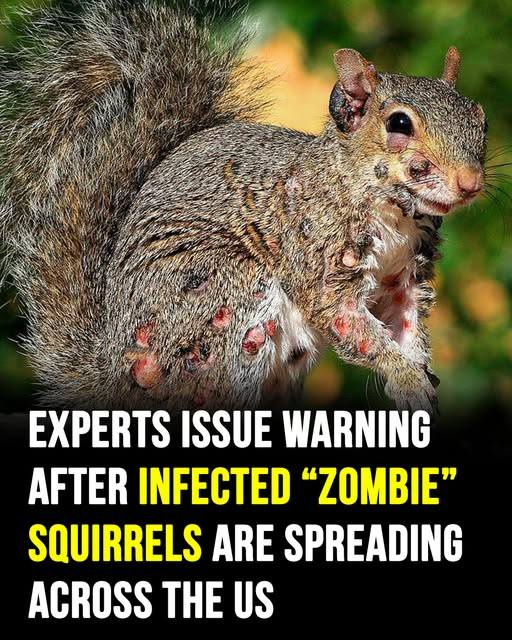
Across the United States, a strange and unsettling phenomenon has left many people both horrified and fascinated. Photos circulating online show squirrels with grotesque growths on their faces and bodies, sometimes with oozing sores and swollen tissue that look like something out of a horror film. The images, which first began appearing on Reddit and Facebook, quickly went viral. Some shocked commenters dubbed them “zombie squirrels,” while others expressed heartbreak and concern for the creatures’ suffering.
One of the first widely shared posts came from a social media user who snapped a picture of a backyard squirrel with an enormous mass covering part of its face. The user asked the internet for help: “Any ideas what is going on with this little fella?” Within hours, the disturbing photo had drawn hundreds of comments, ranging from sympathetic guesses about cancer to wild speculation about new diseases spreading through wildlife.
Experts, however, were quick to weigh in with a more grounded explanation. Wildlife biologists identified the condition as squirrel fibromatosis, often referred to as squirrel pox. This viral disease, while visually disturbing, is actually not new. It has been documented for decades in North American squirrel populations. The virus triggers the growth of tumor-like fibromas on the skin. These growths can vary dramatically in size, sometimes appearing as small nodules but other times ballooning into grotesque lumps that distort the animal’s face or body.
Shevenell Webb, a wildlife biologist, explained that although the appearance is shocking to humans, squirrel pox is part of the natural ecology of these animals. “It looks terrible, but it’s a naturally occurring virus,” Webb said. “In most cases, it will run its course in time.” She emphasized that the disease is not always fatal, though it can certainly make life more difficult for the squirrels who contract it.
The main danger for infected squirrels isn’t the virus itself but the side effects of the growths. When tumors develop around the mouth or eyes, they can interfere with eating, climbing, or avoiding predators. A squirrel unable to forage properly may become weak and more vulnerable, while one that cannot see well might fall prey to hawks, cats, or even cars. In this way, the virus indirectly leads to death for some squirrels, but in many cases, infected animals recover as the fibromas eventually regress.
For concerned animal lovers, the sight of a sick squirrel can spark the instinct to intervene. However, experts strongly caution against trying to capture, feed, or provide treatment to wild squirrels with these growths. Not only is handling wildlife stressful and potentially harmful to the animal, but it also poses risks to humans. While squirrel pox itself is not considered transmissible to people, wild animals can carry parasites, fleas, or secondary infections that do pose hazards.
Instead, wildlife specialists advise that the best course of action is observation from a safe distance. If a community notices a high number of visibly infected squirrels, residents can contact local wildlife authorities or animal control services for guidance. These organizations can monitor outbreaks and determine whether intervention, such as population studies or habitat management, is necessary.
It’s worth noting that squirrel pox is not limited to the United States. Similar viral diseases have been observed in squirrel populations around the world, sometimes with devastating ecological consequences. In the United Kingdom, for example, a related virus carried by invasive gray squirrels has had a devastating impact on native red squirrel populations. While the U.S. situation is different, it highlights how fragile wildlife health can be when new diseases or environmental pressures are introduced.
The viral spread of these squirrel images underscores another reality: in the age of social media, wildlife diseases are now playing out in the public eye. Where once only scientists and biologists might encounter such cases, now everyday people stumble upon them in their neighborhoods and immediately share them online. This can lead to unnecessary panic, but it also creates an opportunity for education. By explaining the science behind these conditions, experts can help the public better understand the balance of nature—even when that balance looks unpleasant.
The term “zombie squirrel” may stick because of its shocking imagery, but the reality is far less apocalyptic. These animals are not undead, nor are they spreading a new plague. They are simply dealing with a virus that has long been part of their ecosystem. As unsettling as the growths look, they do not represent a threat to humans, pets, or public health.
For many, the takeaway is a reminder of how much wildlife endures outside our view. The next time someone sees a squirrel leaping from branch to branch with effortless agility, they may pause to appreciate just how many challenges these small creatures face in their daily struggle to survive—disease being only one of them. The sick squirrels making headlines today may look monstrous, but they are also a testament to nature’s resilience.
In the end, experts hope that public awareness will translate into responsible behavior: no touching, no capturing, and no panicked assumptions. Instead, we should keep a respectful distance, report unusual cases to local authorities, and remember that the natural world is often far more complex and strange than we realize. The “zombie squirrels” may look like something from a nightmare, but they are simply another example of how life in the wild doesn’t always fit the comforting picture we expect.
